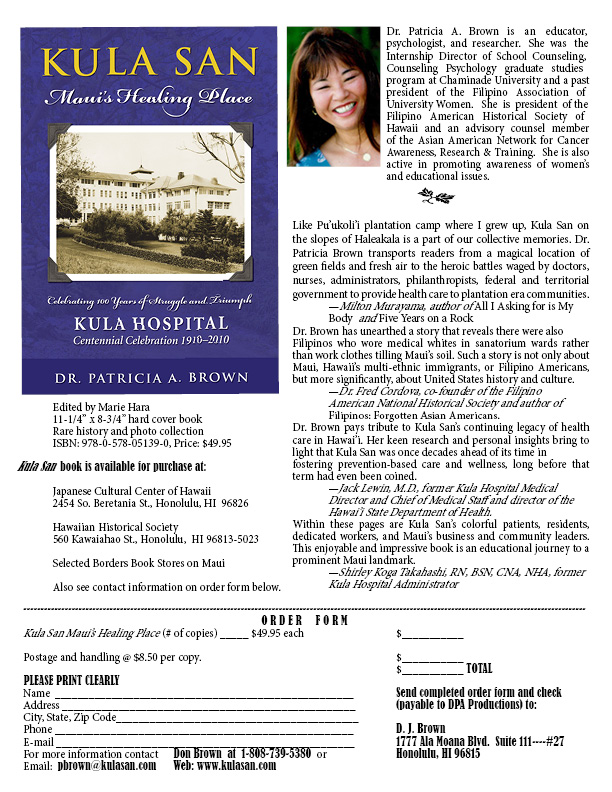The Book
Japanese and Kula San
During the early 20th century, Hawaii’s immigrant groups were among those adversely impacted by tuberculosis, the dreaded “white plague” that spread throughout Hawaii’s plantation era communities. Among those  affected by the disease were the Japanese, who comprised the largest ethnic group of tuberculosis patients at Kula Sanatorium, which had a reputation as a leading national and international health care institution. Kula San Maui’s Healing Place, a 325-page pictorial history book by Dr. Patricia Brown, chronicles the self-sustaining hospital’s vibrant past and unravels the personal stories of patients, employees, and community leaders.
affected by the disease were the Japanese, who comprised the largest ethnic group of tuberculosis patients at Kula Sanatorium, which had a reputation as a leading national and international health care institution. Kula San Maui’s Healing Place, a 325-page pictorial history book by Dr. Patricia Brown, chronicles the self-sustaining hospital’s vibrant past and unravels the personal stories of patients, employees, and community leaders.
Dr. Brown also documents the hospital’s patients and workers —Japanese, Filipinos, Portuguese, Chinese, Hawaiian, Puerto Ricans and Caucasians—coming together as providers, protectors, nurturers, and healers in a compassionate, caring non-traditional hospital environment. The book not only documents the pain, fear and death experienced by its multi-ethnic patients, but also highlights the support provided by the ‘ohana that formed at Kula San, as the hospital was affectionately known by the people of Maui.
Filipinos at Kula San
The Filipinos soon followed as the second largest group admitted at this Sanatorium (Kula San’s Filipino story will also be briefly presented on this website)
Portuguese, Chinese, Hawaiian, Puerto Rican, and Caucasian stories will be added.
THE PEOPLE AND LIFE AT KULA SAN
Disbursed throughout the book are stories of Japanese patients who suffered from tuberculosis nearly 100 years ago. Many were shunned, disgraced and humiliated. However, they received support from the community to reclaim their self-esteem and dignity. For example, a group of Japanese associations including the Japanese White Cross Society, Japanese Methodist Church, and Meisho made annual trips to the hospital to visit with the patients and brought small gifts for them.
There are also clusters of human interests stories. In particular is a gripping story of the life of James Sadato Kurisu, who was a Kula San patient during the early 1920s. Others such as 79-year-old Albert Amuro, 102 year-old Kazuma Okumura, and 99 year-old Hiroshi Matsui share the fascinating details of how their lives were impacted by Kula San. The book brings to life the journey and joy of Kula San’s patients. Additionally, the stories of Japanese employees from 1910 to 1970 provide a glimpse of daily life at Kula Sanatorium.
ORDER FORM for: Kula San Maui’s Healing Place

Helping Hands
Blessing by Reverend Kahu Lowaena Hau,
Pastor Ka’ahumanu Church, Wailuku Maui
Preface by editor, Marie Hara,
Assistant Professor, Department of English, University of Hawai’i at Manoa
The Kula Hospital Centennial: Past, Present and Future by Dr. Jack Lewin,
CEO, American College of Cardiology
Former Medical Director and Chief of the Medical Staff, Kula Hospital
Past Hawai’i State Director of Health
TB and Kula San by Milton Murayama,
Writer, Author of All I Asking For Is My Body, Five Years On A Rock, Plantation Boy and Dying In A Strange Land
